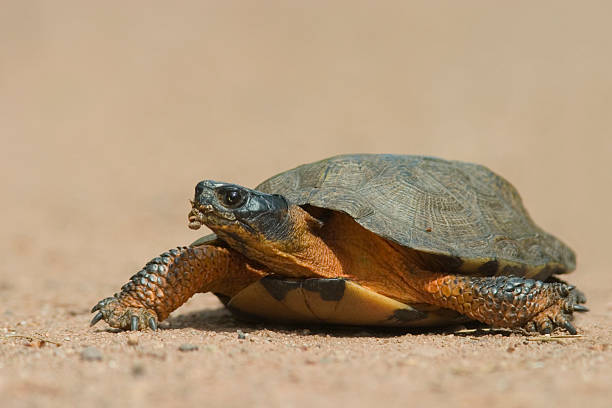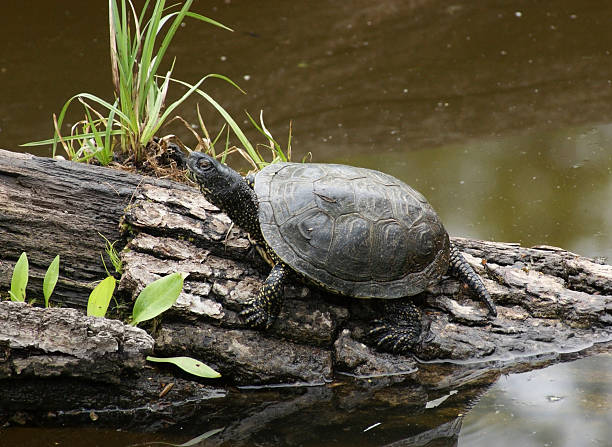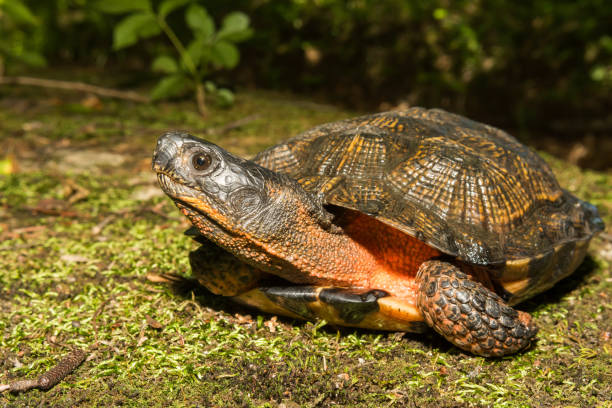Table of Contents
Scientific Classification
| Kingdom | Animalia |
| Phylum | Chordata |
| Class | Reptilia |
| Order | Testudines |
| Family | Emydidae |
| Genus | Glyptemys |
| Species | Glyptemys insculpta |
| Scientific Name | Glyptemys insculpta |
Description
The wood turtle is a medium-sized, semi-aquatic turtle known for its distinctive appearance. Its rugged, sculpted shell features a brown or gray color with deep growth rings, while its plastron is a striking yellow adorned with black blotches. The limbs and neck of the wood turtle often have hints of orange or red, making it easily identifiable. Adults usually measure between 5.5 to 8 inches in length and weigh around 1 to 2 pounds. They are recognized for their intelligence and problem-solving abilities, which distinguishes them from many other turtle species.

Distribution
Wood turtles are native to North America, primarily inhabiting the northeastern United States and southeastern Canada. Their range extends from Nova Scotia and New Brunswick down to Virginia, with some smaller populations found in the Midwest, particularly in Minnesota and Iowa.
Habitat
Wood turtles thrive in a combination of aquatic and land-based habitats. They are commonly spotted near slow-moving streams, rivers, and wetlands that have sandy or muddy bottoms. Additionally, these turtles venture into forests, meadows, and agricultural areas. They frequently travel considerable distances on land in search of food and potential mates.
Diet
Wood turtles are omnivores with a highly varied diet. They consume:
Fruits and berries
Mushrooms
Leaves and flowers
Earthworms
Insects and slugs
Small fish and amphibians make up a varied diet. This helps them adjust to changes in food availability throughout the seasons.
Behavior
Wood turtles are active during the day, which makes them diurnal. They are quite intelligent, capable of solving problems and even recognizing their caretakers in captivity. Unlike many other turtle species, they are not solely aquatic; they can also cover significant distances on land. To survive the winter months, they hibernate in streambeds.
Lifespan
Wood turtles have a long lifespan, with some individuals living up to 50 years in the wild. In captivity, they can live even longer. Unfortunately, their longevity is at risk due to habitat destruction and human activities.
Reproduction and Lifecycle
Mating occurs in the spring and fall, with males frequently displaying aggressive behavior to win over females. Once mating is complete, females will lay between 4 to 12 eggs in sandy or loose soil, usually close to a water source. The incubation period for the eggs lasts around 60 to 75 days before they hatch. Unfortunately, hatchlings encounter numerous threats from predators and typically take several years to reach maturity.

Predators
Wood turtles face predation at different stages of life. Common predators include:
Raccoons
Skunks
Foxes
Birds of prey
Large fish
Humans indirectly threaten them through habitat destruction and the pet trade. Their camouflage helps them hide, but nest predation is still a big danger.
Adaptations
Wood turtles possess various adaptations that enhance their chances of survival:
Camouflage: Their shells, which are earthy in color, seamlessly blend into the forest floor and riverbanks.
Intelligence: They demonstrate problem-solving abilities, a rare characteristic among reptiles.
Hard Shell: Their tough shells offer protection from predators.
Seasonal Movement: They transition between water and land as necessary, reducing competition for resources.
Conservation Status
Wood turtles are listed as a species of concern due to habitat loss, pollution, and poaching. Conservation efforts protect natural habitats. They also control the pet trade and raise awareness of ecological value. Many states have made laws to protect wood turtles. Conservation groups also monitor and help restore their numbers.
The wood turtle is an interesting and smart reptile. It has an important role in its ecosystem.



